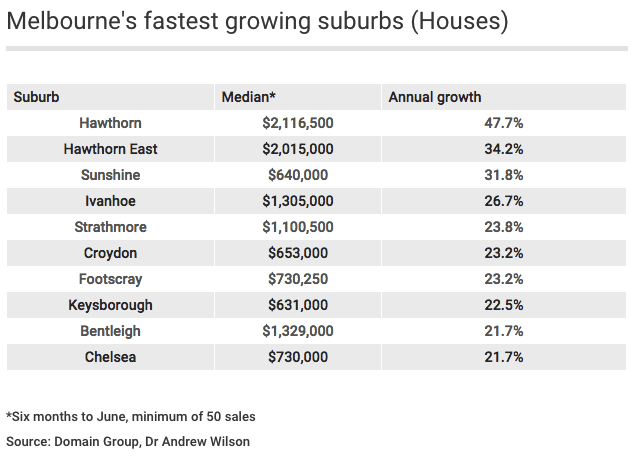First publish: domain.com.au Christina Zhou
Gone are the days where moving to the outer suburbs or going west presented an affordable way to buy a house.
A clutch of traditional blue-collar Melbourne suburbs have clocked the strongest price growth across the city over the past year, with their house median jumping more than 20 per cent.
Keysborough, 27 kilometres south-east of the CBD, is increasingly on buyers’ radar as they find themselves priced out of bayside and middle-ring suburbs. The house median has jumped 22.5 per cent over the past year to $631,000, Domain Group data shows.
Chelsea in the south-east, Croydon in the outer east and Sunshine in the west were also among the fastest growing suburbs for house prices in the past year.
Ben Nguyen of Barry Plant Keysborough said before the property boom, buyers from cheaper neighbouring suburbs such as Springvale South and Noble Park upgraded to Keysborough.
Whereas the suburb was now attracting more buyers priced out of Clayton and bayside pockets including Aspendale, Chelsea and Edithvale – which gave the area a boost, he said.
Several houses the agency resold in about a 12-month period gained more than $100,000, Mr Nguyen added.
A case in point is a four-bedroom house at 45 Locharn Crescent in Keysborough, which sold for $632,000 last October after last transacting for $481,498 in June 2014.
Keysborough is also a tale of two pockets; the old part with established properties and a developing precinct with new estates.
“The new estates in Keysborough have doubled the population; where it was once farmland has become residential,” Mr Nguyen said.
In the west, Footscray’s median house price of $730,250 is now not far from Melbourne’s median, which is at a new record over the June quarter.
Biggin and Scott Yarraville director Tristan Tomasino said Footscray was continuing to attract buyers priced out of Yarraville, Seddon and Newport.
There was a “huge gentrification” of young couples and professionals moving from the east to Footscray,” he said. “And subsequently they’ve got a lot more money to spend, and that’s why prices have got pushed up.”
A charming four-bedroom period house at 46 Stirling Street in Footscray that last transacted for $285,000 in 1998, sold for $1,346,000 at auction in March.
Broadsheet-featured cafes and restaurants had also taken off in Footscray over the past 12 months – and where there’s quality coffee, there was usually good capital growth, Mr Tomasino added.
House price growth in suburbs with proximity to prestigious schools also continued to outperform.
Hawthorn and Hawthorn East recorded the biggest growth, where the medians jumped more than 30 per cent to $2,116,500 and $2,015,000 respectively.
Their performance bucked the general trend of flat prices growth in the inner east, and Domain Group chief economist Andrew Wilson said there may be a bit of a catch-up in those suburbs.
The mix of higher-priced properties sold over the six months to June in Hawthorn – a suburb with a diversity of property types – could also influence its median.
The house median in Bentleigh, which is partially McKinnon Secondary College zoned, also jumped 21.7 per cent to $1,329,000.
Simon Pintado, of Buxton Bentleigh, said Bentleigh and McKinnon houses appeared to be good value compared to bayside suburbs such as Brighton, Elwood and Sandringham.
“A lot of people are happy to geographically compromise for the right property,” he said.
Mr Pintado believed the removal of level crossings in the area is likely to further boost the value of Bentleigh homes.
Dr Wilson said significant house price growth in Strathmore and Ivanhoe showed prestige buyers were still active.
People were rediscovering the middle north-east of Melbourne (such as Ivanhoe and Heidelberg), which would work its way out to Greensborough, Rosanna and Bundoora, he said.
“You can almost feel the energy pushing outwards.”
